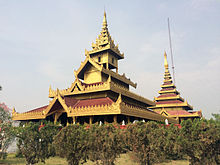
Shwebon Yadana Mingala Palace ( Burmese: ရွှေဘုံရတနာ မင်္ဂလာနန်းတော်) is a royal palace in Shwebo, Myanmar. The palace was originally built in 1753 AD by King Alaungphaya U Aung Zeya, who was the first founder of the Konbaung dynasty [1] and was capital city until 1760 when the capital was moved to nearby Sagain. Different to other Royal Palaces in Myanmar it was centered on a large graduated pavilion. [2] Having two walls, the outer wall forms a 3.5 km square closure, surrounded by a moat. With the tomb of King Alaungpaya located to the southeast of the palace building. [3] It was reconstructed in 1999 [4] based on a mid 19th-century manuscript on a November 1853 expedition to collect the remaining timber posts of the palace, carve them out, and turn them into sacred images.. [2] It has 200m long city walls.
References
- ^ "Untitled Document". Archived from the original on 2018-02-22. Retrieved 2018-02-12.
- ^ a b Tainturier, François (2014). "Of Golden Palaces and Celebrated Rulers: Inventing Traditions in Pre-colonial and Contemporary Myanmar". Journal of Burma Studies. 18 (2): 223–258. doi: 10.1353/jbs.2014.0015. ISSN 2010-314X.
- ^ Yamada, Koji (2021). "A Research on the Applicability of the Mandalay Model to Other Historical Capital Cities of the Burmese Kingdom". Journal of JSCE. 9 (1): 184–197. doi: 10.2208/journalofjsce.9.1_184.
- ^ "Ministry of Culture". Archived from the original on 2012-08-03. Retrieved 2012-02-19.

Shwebon Yadana Mingala Palace ( Burmese: ရွှေဘုံရတနာ မင်္ဂလာနန်းတော်) is a royal palace in Shwebo, Myanmar. The palace was originally built in 1753 AD by King Alaungphaya U Aung Zeya, who was the first founder of the Konbaung dynasty [1] and was capital city until 1760 when the capital was moved to nearby Sagain. Different to other Royal Palaces in Myanmar it was centered on a large graduated pavilion. [2] Having two walls, the outer wall forms a 3.5 km square closure, surrounded by a moat. With the tomb of King Alaungpaya located to the southeast of the palace building. [3] It was reconstructed in 1999 [4] based on a mid 19th-century manuscript on a November 1853 expedition to collect the remaining timber posts of the palace, carve them out, and turn them into sacred images.. [2] It has 200m long city walls.
References
- ^ "Untitled Document". Archived from the original on 2018-02-22. Retrieved 2018-02-12.
- ^ a b Tainturier, François (2014). "Of Golden Palaces and Celebrated Rulers: Inventing Traditions in Pre-colonial and Contemporary Myanmar". Journal of Burma Studies. 18 (2): 223–258. doi: 10.1353/jbs.2014.0015. ISSN 2010-314X.
- ^ Yamada, Koji (2021). "A Research on the Applicability of the Mandalay Model to Other Historical Capital Cities of the Burmese Kingdom". Journal of JSCE. 9 (1): 184–197. doi: 10.2208/journalofjsce.9.1_184.
- ^ "Ministry of Culture". Archived from the original on 2012-08-03. Retrieved 2012-02-19.